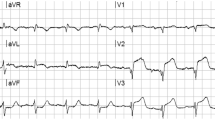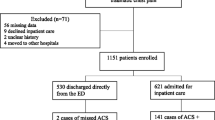Abstract
Background/Objectives. Rapid risk stratification of the patient with acute chest pain is essential to select the best management. We investigated the value of the ECG at first medical contact to determine size of the ischaemic myocardial area and thereby severity of risk.
Methods. In 386 patients with acute chest pain, ECG findings were correlated with the coronary angiogram. Using ST-segment deviation patterns the location of the coronary culprit lesion was predicted and thereby size of the area at risk. Four groups of patients were present. Those with a narrow QRS and a total 12-lead ST-segment deviation score of ≥5 mm (group 1) or ≤4 mm (group 2); a QRS width of ≥120 ms (group 3), and patients with previous coronary bypass grafting (CABG) or percutaneous coronary intervention (PCI) (group 4).
Results. Correct coronary culprit lesion localisation was possible in 84% of the 185 patients in group 1, 40% of the total cohort. Accurate prediction was not possible in most patients in groups 2, 3 and 4, in spite of extensive coronary artery disease in group 3 and 4.
Conclusions. Using the 12-lead ECG the size of the myocardial area at risk can be accurately predicted when the total ST-segment deviation score is ≥5 mm, allowing identification of those in need of a PCI. In most patients with bundle branch block, previous CABG or PCI, the ECG can not localise the culprit lesion. This approach simplifies and accelerates decision-making at first medical contact. (Neth Heart J 2010;18:301-6.)


Similar content being viewed by others
References
Birnbaum Y, Sclarovky S, Solodky A, et al. Prediction of the level of left anterior descending coronary artery obstruction during anterior wall acute myocardial infarction by the admission electrocardiogram. Am J Cardiol. 1993;72:823-6.
Herz I, Assali AR, Adler Y, et al. New electrocardiographic criteria for predicting either the right or left circumflex artery as the culprit coronary artery in inferior wall acute myocardial infarction. Am J Cardiol. 1997;80:1343-5.
Zimetbaum PJ, Krishnan S, Gold A, et al. Usefulness of ST-segment elevation in lead III exceeding that of lead II for identifying the location of the totally occluded coronary artery in inferior wall myocardial infarction. Am J Cardiol. 1998;81:918-9.
Sclarovsky S. Electrocardiography of acute myocardial ischemic syndromes. London, Martin Dunitz Ltd; 1999.
Engelen DJ, Gorgels AP, Cheriex EC, et al. Value of the electrocardiogram in localizing the occlusion site in the left anterior descending coronary artery in acute anterior myocardial infarction. J Am Cardiol. 1999;34:389-95.
Yamaji H, Iwasachi S, Kusachi S, et al. Prediction of acute left main coronary obstruction by 12-lead electrocardiogram: aVR ST-elevation with less V1 ST-segment elevation. J Am Coll Cardiol. 2001;38:1348-54.
Birnbaum Y, Drew BJ. The electrocardiogram in ST elevation acute myocardial infarction: correlation with coronary anatomy and prognosis. Postgrad Med J. 2003;79:490-504.
Fiol M, Cygankiewicz I, Carillo A, et al. Value of electrocardiographic algorithm based on “ups and downs” of ST in assessment of a culprit artery in evolving inferior wall acute myocardial infarction Am J Cardiol. 2004;94:709-14.
Erhardt LR, Sjogren A, Wahlberg I. Single right sided precordial lead in the diagnosis of right ventricular involvement in inferior myocardial infarction. Am Heart J. 1976;91;571-6.
Braat SH, Brugada P, De Zwaan C, et al. Value of the electrocardiogram in diagnosing right ventricular involvement in patients with an acute inferior wall myocardial infarction. Br Heart J. 1983;49:368-72.
Saski K, Yotsukura M, Sakata K, et al. Relation of ST-segment changes in inferior leads during anterior wall acute myocardial infarction to length and occlusion site of the left anterior descending coronary artery. Am J Cardiol. 2001;87:1340-6.
Zimetbaum PJ, Josephson ME. Use of the electrocardiogram in acute myocardial infarction. N Engl J Med. 2003;348:933-40.
Atar S, Barbagelata A, Birnbaum Y. Electrocardiographic diagnosis of ST-elevation myocardial infarction. Cardiol Clin. 2006;24:343-65.
Eskola MJ, Nikus KC, Holmvang L, et al. Value of the 12-lead electrocardiogram to define the level of obstruction in acute anterior wall myocardial infarction: correlation to coronary angiography and clinical outcome in the DANAMI-2 trial. Int J Cardiol. 2009;131:378-83.
Wang SS, Paynter l, Kelly RV, et al. Electrocardiographic determination of culprit lesion site in patients with acute coronary events. J Electrocardol. 2009;42:46-51.
Wellens HJJ, Conover M. The ECG in Emergency Decision Making, 2nd edition, St Louis: Elsevier/Saunders; 2006: p 3-16.
Foerster JM, Vera Z, Janzen DA, et al. Evaluation of precordial orthogonal vector cardiographic lead ST segment magnitude in the assessment of myocardial ischemia injury. Circulation. 1977;55:728-35.
Hurst JW. Methods used to interpret the 12-lead electrocardiogram: pattern memorization vs the use of the vector concept. Clin Cardiol.2004;24:4-13.
Gorgels APM. Chapter 3 Electrocardiography. In: Willerson JT, Cohn JN, Wellens HJJ, Holmes DR Jr, eds. Cardiovascular Medicine, 3d ed. London: Springer; 2007:60-7.
Bar FW, Vermeer F, De Zwaan C, et al. Value of the admission electrocardiogram in predicting outcome of thrombolytic therapy in acute myocardial infarction. Am J Cardiol. 1987;59:6-13.
Antman EM, Hand M, Armstrong PW, et al. 2007 Focused update of the ACC/AHA 2004 guidelines for the management of patients with ST-elevation myocardial infarction: a report of the American College of Cardiology/American Heart Association Task Force on Practice Guidelines. J Am Coll Cardiol. 2008;51:1210-47.
Van de Werf F, Bax J, Betriu A, et al. Management of acute myocardial infarction in patients presenting with persistent ST-segment elevation. The Task Force on the management of ST-segment elevation acute myocardial infarction of the European Society of Cardiology. Eur Heart J. 2008;29:2909-45.
Antman EM. Time is muscle. Translation into practice. J Am Coll Cardiol. 2008; 52: 1216-21.
Diercks DB, Kontos CK, Chen AY, et al. Utilization and impact of pre-hospital electrocardiograms for patients with acute ST-segment elevation myocardial infarction. Data from the NCDR ( National Cardiovascular Data Registry) ACTION ( Acute Coronary Treatment and Intervention Outcomes Network) registry. J Am Coll Cardiol. 2009;53:161-6.
Eskola MJ, Nikus KC, Voipio-Pulkki LM, et al. Detection of proximal coronary occlusion in acute coronary syndrome: a feasibility study using computerized electrocardiographic analysis. Ann Noninvasive Electrocardiol. 2007;12:301-5.
Macfarlane PW. Age, sex and the ST amplitude in health and disease. J Electrocardiol. 2001;34:S35-S41.
Cantor WJ, Fitchett D, Borgundvaag B, et al, for the TRANSFER-AMI Trial Investigators. Routine early angioplasty after fibrinolysis for acute myocardial Infarction. N Engl J Med. 2009;360:2705-18.
Berry C, Pieper KS, White HD, et al. Patients with prior coronary bypass grafting have a poor outcome after myocardial infarction: an analysis of the VALsartan in acute myocardial infarction trial (VALIANT). Eur Heart J. 2009;30:1450-6.
Author information
Authors and Affiliations
Additional information
Marienhospital Herne, Med Klinik II, Ruhr University, Herne, Germany
Department of Cardiology, Isala Clinics, Zwolle, the Netherlands
Department of Cardiology, Academic Hospital, Maastricht, the Netherlands
Cardiovascular Research Institute, Maastricht, the Netherlands
H.J. Wellens 21 Henric van Veldekeplein, 6211 TG Maastricht, the Netherlands
Rights and permissions
About this article
Cite this article
Meissner, A., Gorgels, A.P. & Wellens, H.J. The value of the ECG for decision-making at first medical contact in the patient with acute chest pain . NHJL 18, 301–306 (2010). https://doi.org/10.1007/BF03091780
Issue Date:
DOI: https://doi.org/10.1007/BF03091780




